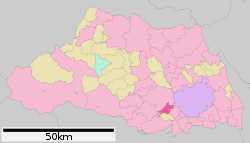Fujimino, Saitama
Fujimino (ふじみ野市, Fujimino-shi) is a city located in Saitama Prefecture, Japan. As of 1 February 2016, the city had an estimated population of 111,218, and a population density of 7600 persons per km². Its total area is 14.64 square kilometres (5.65 sq mi).
Fujimino ふじみ野市 | |
|---|---|
Fujimino City Hall | |
 Flag  Seal | |
 Location of Fujimino in Saitama Prefecture | |
 Fujimino Location of Fujimino in Saitama Prefecture | |
| Coordinates: 35°52′46.3″N 139°31′11.2″E | |
| Country | Japan |
| Region | Kantō |
| Prefecture | Saitama Prefecture |
| Government | |
| • Mayor | Hiroshi Takahata (since November 2009) |
| Area | |
| • Total | 14.64 km2 (5.65 sq mi) |
| Population (February 2016) | |
| • Total | 111,218 |
| • Density | 7,600/km2 (20,000/sq mi) |
| Time zone | UTC+9 (Japan Standard Time) |
| Phone number | 049-261-2611 |
| Address | 1-1-1 Kamifukuoka, Fujimino-shi, Saitama-ken 356-8501 |
| Website | http://www.city.fujimino.saitama.jp/ |
Geography
Fujimino is located in southern Saitama, on the northern edge of the Musashino Terrace, and is approximately 30 kilometers from downtown Tokyo.
Surrounding municipalities
History
Earthenware pottery fragments from the Kamifukuoka Shell Mound dating to the Early Jōmon period, were discovered beneath the Dainihon Print Company in Fujimino, indicating a long period of settlement. The city also has an important early Kofun period archaeological site, the Gongenyama Tumuli Cluster, from the late 3rd century. During the Edo period, the port of Fukuoka was an important river port on a branch of the Arakawa River and was under the control of Kawagoe Domain. The modern village of Fukuoka was created within Iruma District, Saitama with the establishment of the municipalities system on April 1, 1889. The first public housing estates (Uenodai and Kasumigaoka) in Japan were built in Fukuoka after the Second World War. The village was raised to town status in 1960 and to city status on April 10, 1972, changing its name to Kamifukuoka to avoid confusion with the more famous city of Fukuoka in Kyushu. The modern city of Fujimino was established on October 1, 2005, from the merger of the city of Kamifukuoka, and the neighboring town of Ōi (from Iruma District).
Economy
Due to this location, Fujimino is primarily a bedroom community with over 25% of its population commuting to the Tokyo metropolis for work. There are a number of industrial parks in the city.
Education
Fujimino has 13 elementary schools, six middle schools, and one high school. Bunkyo University also has a campus in Fujimino.
Public facilities
There are two libraries, two public swimming pools (summer season only), and a number of public halls and community centres.
Transportation
Railway
Highway
Local attractions
- Jizoin Temple, famous for a weeping cherry tree which is more than 300 years old.
- Benten-no-mori Park, which has a small temple noted for cherry blossoms in spring, and kudzu in autumn.
- Shingashi River, used for transporting goods in the Edo period, with a warehouse from the 1870s now called the Fukuokagashi Riverside Heritage Hall.
- Green Park, on the bank of the Shingashi River, noted as a location where Tokugawa Ieyasu used to go falconing.
- Chūō Park.
Festivals
There are two major festivals in Fujimino: the Kamifukuoka Tanabata Festival and the Oi Festival.
Kamifukuoka Tanabata Festival
This is a lively festival held on the first Saturday and Sunday of August every year since more than 50 years ago. It includes a bamboo decoration contest, Awa Odori dancing, Bon Odori dancing, and traditional taiko drumming.
Noted people from Fujimino
- Hikari Ōta, comedian
- Yumi Kakazu, voice actress
- Shigenobu Shima, professional baseball player
- Eri Nitta, musician and actress
- Mari Hoshino, actress
- Aoi Hiiragi, manga artist
References
- Confusingly, Fujimino Station is located in the neighbouring city of Fujimi
External links
| Wikimedia Commons has media related to Fujimino, Saitama. |
- Official Website (in Japanese)